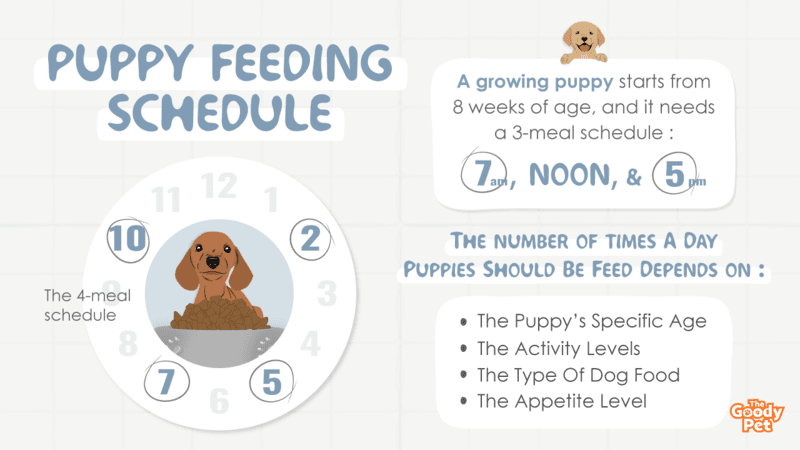A puppy feeding schedule can help you make sure that your little one is getting the nutrition it needs.
Generally, feed your puppy at least three times a day, but up to six. The amount is determined by weight and the number of meals you feed. You can use a food scale to weigh out their food or ask your veterinarian for advice on how much food your puppy should be getting.
In the meantime, here are some guidelines that may help you get started:
When Is The Best Time To Feed My Puppy?
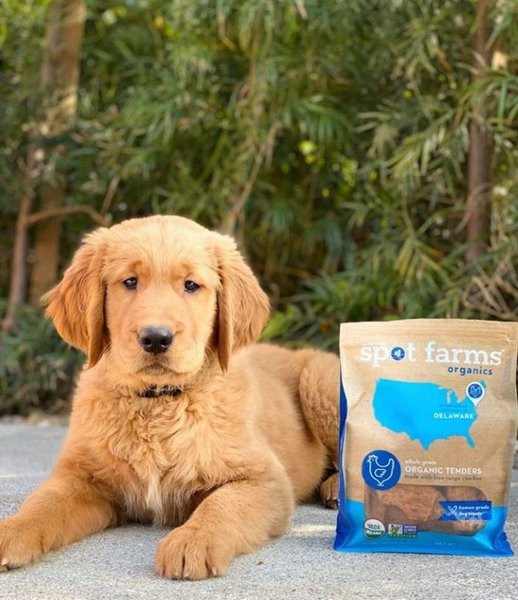
To establish a good feeding routine for your puppy, one of the critical factors to consider is their age. This determines a lot, from their appetite to how much you can feed the puppy. During breastfeeding and weaning stages, free-feeding schedules are acceptable as the dogs are unlikely to overeat. This is because puppies have small tummies and do not do enough to warrant a high energy supply.
However, when your dog reaches 8 weeks of age you should switch to a more deliberate schedule in which case there are three main meal schedule options to choose from.
One of the best for the growing and more active puppy is the three-meal schedule with mealtimes at 7am, noon, and 5pm. You could also make it work for these mealtimes at 7am, 10am, 2pm, and 5pm.
The two-meal schedule could also work if you are dealing with a generally less active puppy or one with larger portions per day. In this case, allow 12 hours to pass between the first and the last meal.
Whether you go for the four-meal schedule or the two-meal option, it is important to make sure that your puppy gets its first meal early in the day. You could time this based on how early they wake up, in which 7 to 9 am should work.
The last meal should also be in the early evening hours. This allows proper digestion and could give you a potty break chance before they go to bed. In this case, it is best to make sure you do not feed them after 5 pm if possible.
How Can I Know How Many Times A Day Should A Puppy Eat?
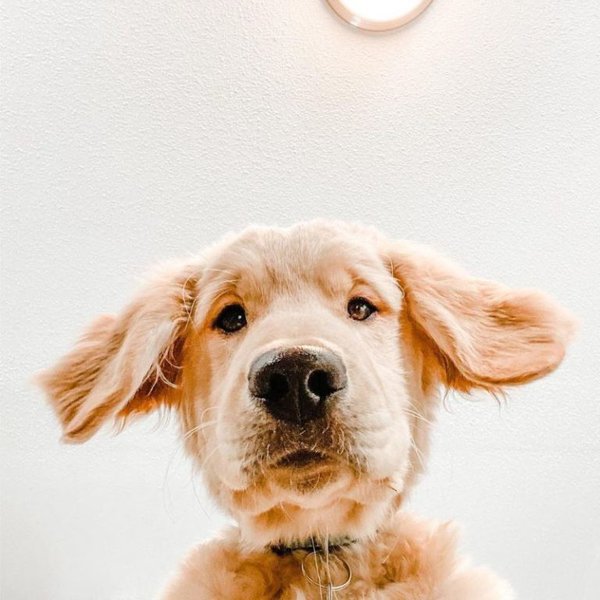
So, how do you know which of the meal plans to adopt for your puppy? The number of times you should feed your little furry buddy depends on many factors. These establish a balance to prevent overeating or undernutrition. Here are four of the most important of these, so you know when to feed your puppy four times a day and when to switch to a two- or three-meal schedule.
The Puppy’s Specific Age
Younger puppies, especially those below the age of six weeks, do not tend to eat a lot. This is because they are not very active and still have low-capacity stomachs. They can thus survive on 2 or 3 meals per day if you want to stick to a schedule.
The Activity Levels
Active puppies need a lot of energy to keep up with their active lifestyles. As your pooch gets more adventurous and playful, it may be time to switch from 2 to 4 meals per day. This ensures that the energy they burn through playing is replenished multiple times in the day to keep them going.
The Type Of Dog Food You Are Feeding Them
The puppy does not really need many mealtimes with the wet dog food as it is very filling. Therefore, you could stick to longer meal intervals in a two- or three-meal daily schedule. However, if they are eating dry dog food, then you might want to feed them four or even six times a day to satisfy your dog’s growing appetite.
The Appetite Level
Speaking of appetite, it also determines how often you could feed your puppy. Those who eat more would benefit from smaller portions spread out over more mealtimes. However, fewer meal times could work if your puppy has low appetite levels or is simply a picky eater.
Can You Overfeed A Puppy?
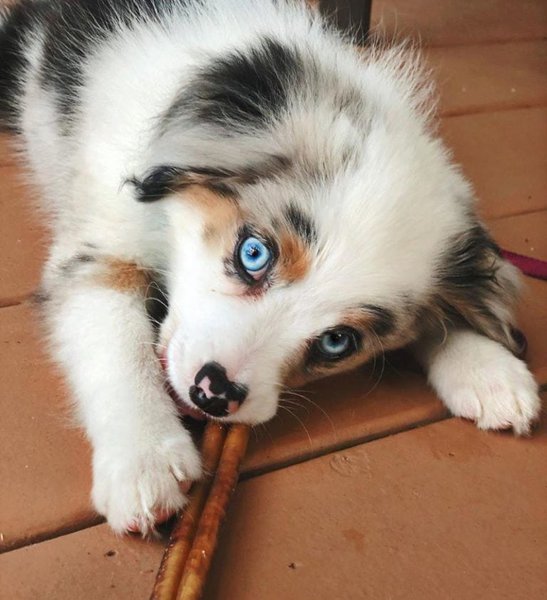
Small puppies should eat about a cup or less every day.
To a new dog owner, this may seem cruel. It is these sentiments that lead a lot of us to overfeed our beloved pooches. Yes, it is possible to do this, and it often has major, unpleasant consequences. Here is how you can tell when you are overfeeding a puppy.
Vomiting After Meals
This happens when the puppy is either eating too much or too fast. The stomach may not be able to handle the large volumes, especially when they are young, in which case it just sends the food back up, causing vomiting.
Reduced Activity After Eating
Many dogs like to relax a little after a meal. However, they soon bounce back, energized by the meal and ready to play. If your pup is reduced to an immobile and inactive mess after a meal, then it could be because they are eating too much.
Excessive Weight Gain
This takes a little longer to manifest but is the clearest indication that you may be overfeeding your puppy. You can tell with some subtle clues like the loss of normal body contour, less palpable ribs, and many others.
Untouched Water Bowls
More often than not, dogs drink their water after they have enjoyed their meals. However, if they are uncomfortably stuffed, then they may not pay the water bowl any attention after their meals. If you notice this happening a lot, try reducing the portions so that there is space in the tummy left for some water.
Changes In Bowel Habits
Overeating in puppies could lead to an increase in the frequency of pooping per day by as many as five times. You may also notice the change in the consistency of its poop during the day from solid to soft and even diarrhea-like later that evening.
Is Wet Or Dry Food Better For Puppies?
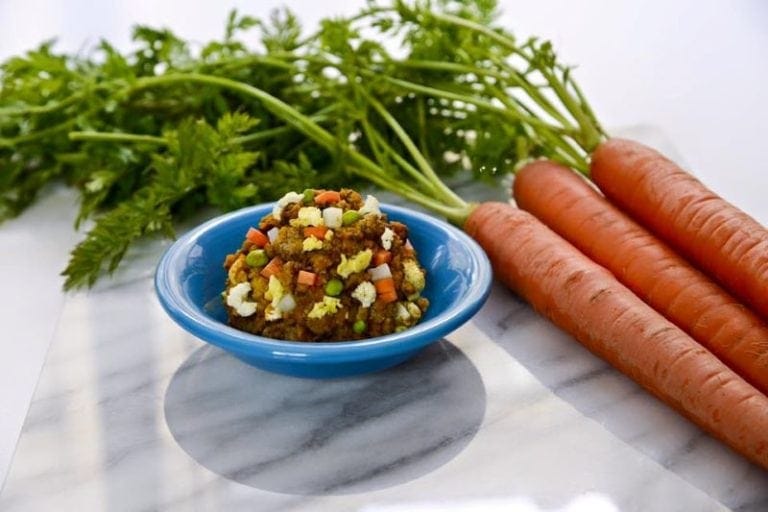
Another major dilemma dog owners often face is picking dry or wet food to feed their dogs. For the most part, wet food is better for puppies for many reasons. However, dry food also has a lot to offer. Let us take a look at what both options mean for your puppy.
Wet dog food has about 60% to 80% water. The resulting soft consistency is particularly handy when feeding puppies as their teeth are not yet strong enough to handle really hard kibble. For this reason, you should start feeding your puppy wet dog food during weaning periods at around 3 to 6 weeks and onwards.
The food also happens to be richer in protein and calories than dry dog food. This is very important for puppies as the protein helps to support growth. In a nutshell, here are a few other major perks you have to expect when feeding your puppy wet dog food.
- It is easier to chew and digest.
- It is rich in protein, fiber, and healthy fats.
- It tastes a lot better.
- It has fewer chemical additives.
As the puppy grows older and develops stronger teeth and a stronger jaw, you can introduce dry dog food. It is particularly useful with older puppies as it is rich in energy needed to support their very active lifestyles. It is also useful during training as it offers a convenient and mess-free way to reward the dog.
In a nutshell, both wet and dry dog food has a lot to offer the puppy. Therefore, it is always a good idea to introduce a mix of the two when they are old enough after starting them off with wet food.
What Are Some Of The Best Puppy Food?
Now that you know when, how much and which wet and dry food to feed your puppy, here is a list of some of the best brands out there. That way, you know what to invest in for a healthy and happy growing pup. Without further ado, here are the three best puppy dog food options on the market.
NomNomNow Dog Food
This is a brand celebrated for its fresh dog food, perfect for puppies at any age. There are four major protein options to choose from, namely beef, chicken, turkey, and pork, guaranteed to whip up an appetite for your pooch. In addition, NomNomNow offers specially formulated and healthy meal plans for dog weight maintenance if you happen to have an obese puppy.
Pet Plate
This is ideal for pet parents who want to go all-natural with their pooch meal plans. Pet Plate uses natural human-grade ingredients that are kettle-cooked for flavor preservation and flash-frozen to keep them nice and fresh.
Ollie Pets
Finally, you could go the customized meals route with Ollie Pets foods for your puppy. They use human-grade ingredients from real meat to superfood fruits and vegetables to ensure that your puppy gets all the nutrients they need to grow and thrive. The best part is that you get to choose what your puppy eats based on their specific dietary needs and preferences.
For more recommendations for the best puppy foods that you can consider for your little best buddy, check out our article below.
Related Questions
How Many Times A Day Should A Puppy Poop?
Puppies poop an average of three times a day, and they can poop as few as once a day or as often as five times a day. This depends on many factors, including their age and specific breed. It is also determined by what, how much, and how often they eat, with those that eat more tending to poop a lot more in the day.
Is It Cruel To Feed A Dog Once A Day?
It is never a good idea to feed your dog once a day. With one meal a day schedule, there is always the risk that your dog will not get as many daily calories as they need. And even if they do, they risk overeating in one go which could lead to issues like indigestion and vomiting.
When Should I Switch From Puppy Food To Adult Food?
Dogs start transitioning into physical maturity at 9 to 12 months for small and medium dogs and 12 to 24 months for larger breeds. This transitional period is the best time to make the switch from puppy to adult food. As with weaning, this should be a slow process, instead of a cold turkey switch from one to the other. Give your dog time to adjust to new flavors and kibble sizes while also allowing their bodies to adapt to the new caloric levels.

